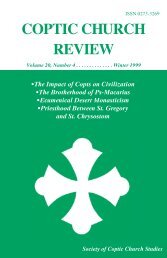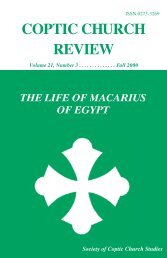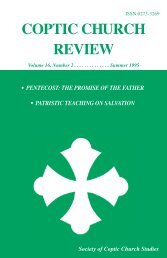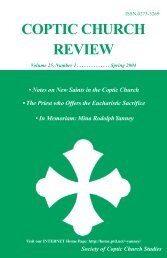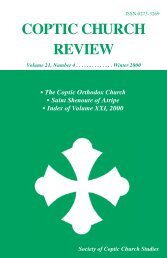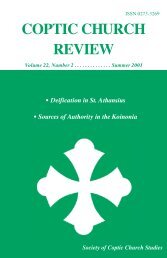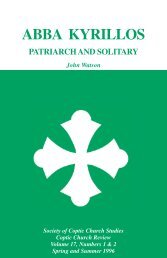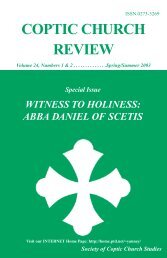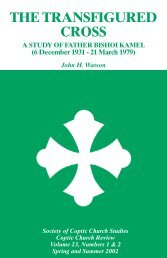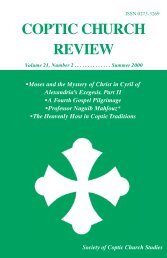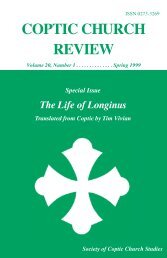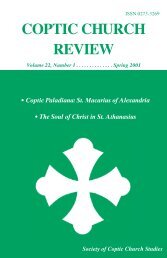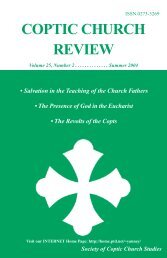2004 Fall.Vol25.#3.pdf - Coptic Church Review
2004 Fall.Vol25.#3.pdf - Coptic Church Review
2004 Fall.Vol25.#3.pdf - Coptic Church Review
Create successful ePaper yourself
Turn your PDF publications into a flip-book with our unique Google optimized e-Paper software.
ART AND COPTIC ICONS:<br />
TWELVE YEARS LATER<br />
John Watson<br />
After more than two decades of contributions to the <strong>Coptic</strong> <strong>Church</strong> <strong>Review</strong>, it<br />
now seems important to recall the examination of ‘transfigured matter’ in the<br />
Summer issue of this journal in 1992. 1 Iconography, with a contemporary Christian<br />
appreciation of the relationship between Art and Theology may, for many, occupy a<br />
central place in modern <strong>Coptic</strong> and recent ecumenical thought.<br />
A number of significant volumes were reviewed in the CCR Vol. 13 No. 12, 2<br />
but in the past decade many more related publications have received careful attention<br />
throughout the Christian world. Not all of these contemporary works were<br />
specifically theological or Christian, but both iconography and modern art deserve<br />
more than a little scrutiny because both have an authentic place in devotion and<br />
general religious thought. The brief phrase ‘Transfigured Matter’, which became<br />
the title of the CCR piece in 1992, has a certain force when we think of Christian<br />
and especially Orthodox icons, but, in the survey that follows, these two words<br />
should also be understood as significant not only for Iconography but also for the<br />
personal psychology of the iconophile, iconodule 3 or anyone who looks at any art<br />
anywhere.<br />
In recent years there has been a considerable demand for icon prints, and for<br />
books about icons and their meaning. Perhaps one of the most accessible texts is<br />
that by Jim Forest, a convert to the Russian Orthodox <strong>Church</strong>, who is able to illustrate,<br />
mainly through a series of careful meditative reflections on classical icons,<br />
the importance of the eye and the heart in the mutual movement between icon and<br />
viewer. Forest’s book is packed with pertinent comment: “The icon shows the<br />
1 <strong>Coptic</strong> <strong>Church</strong> <strong>Review</strong>. Volume 13. Number 2, Transfigured Matter: A Theology of Icons, John<br />
Watson, Summer 1992.<br />
2 Icons, Ed. Gennadios Limouris, WCC, Geneva 1990: Voicing Creations Praise, Jeremy Begbie,<br />
Edinburgh, 1991: Imago Dei, Jaroslav Pelikan, Princeton, USA, 1990: Towards Contemporary<br />
<strong>Coptic</strong> Art, Jacqueline Ascott, Cairo, 1988: <strong>Coptic</strong> Iconography, Stephan René, London 1990.<br />
3 The term ‘iconophile’, translated as ‘lover of icons’ is used by Michel Quenot The Resurrection and<br />
the Icon, SVS Press, NY, 1997 though ‘iconodule’ is more familiar and can be translated as ‘icon<br />
worshipper’ though ‘worshipper with icons’ might be preferred. (See. John Baggley, Doors of<br />
Perception, Mowbray, Oxford 1987. pp.19, 21.).<br />
66




